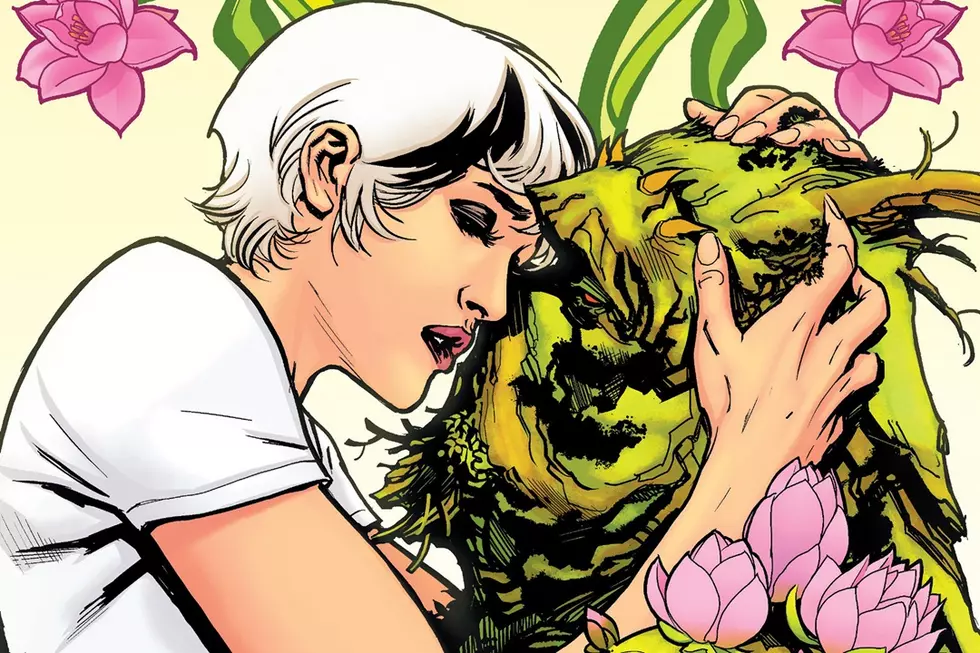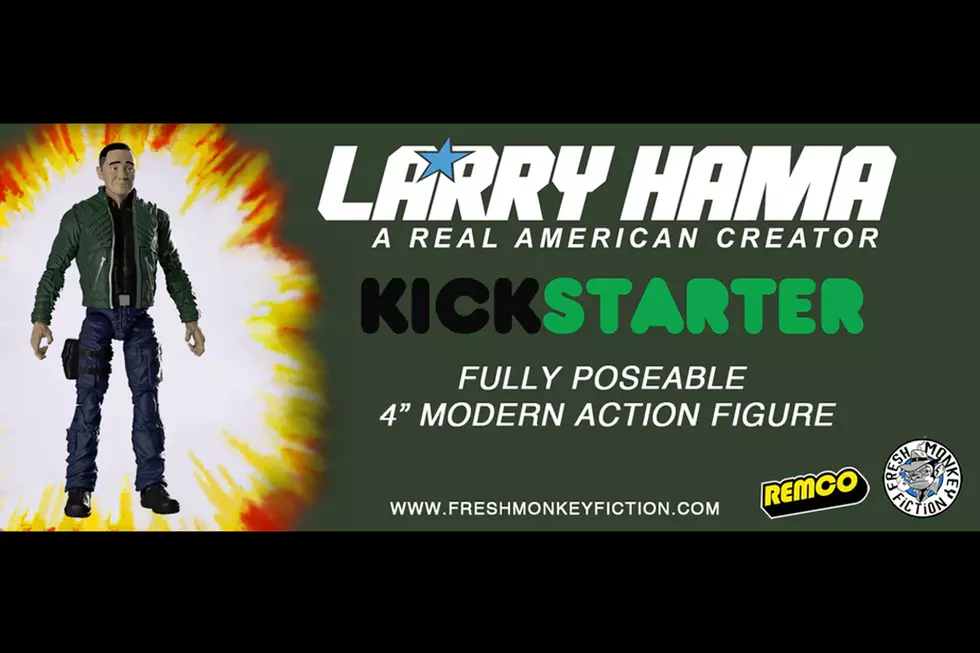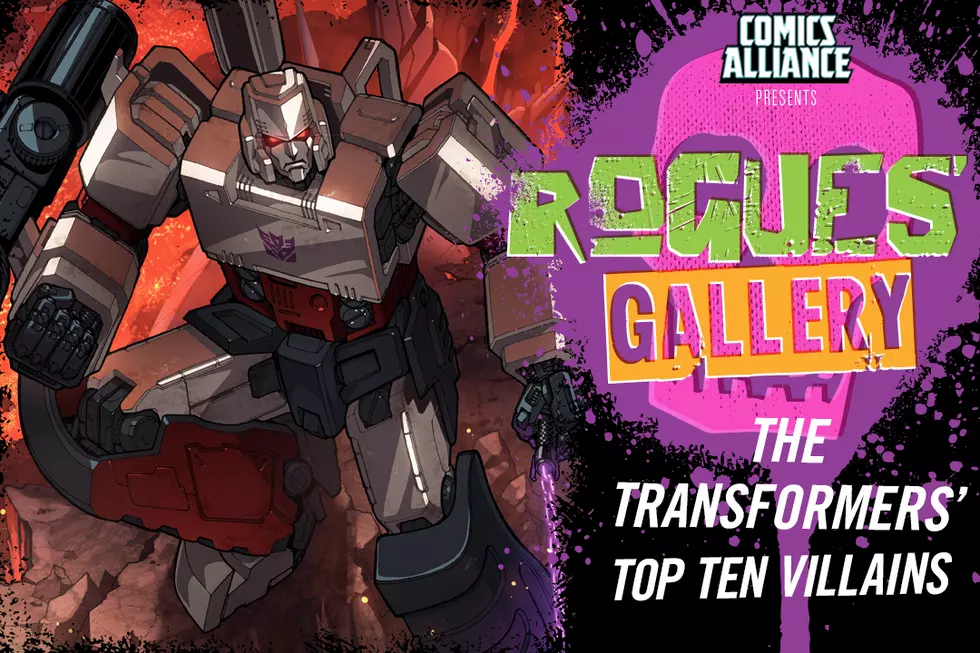
The Decepticobranomicon: Tom Scioli On ‘Transformers vs. GI Joe,’ Part Two
To say that Tom Scioli and John Barber‘s Transformers vs. GI Joe is an unusual comic is underselling things quite a bit. On paper, it’s a natural fit, an ongoing series that follows in the footsteps of earlier books that have combined the two toy lines into one massive interplanetary battle. In practice, though, it’s something a lot bigger, a comic that almost assaults the reader by cramming in as much big, wild stuff as it possibly can — a toy comic so weird, and so great, that it almost feels like it shouldn’t exist.
With the book's second storyline well under way, throwing in everything from Vikings to old gods to Dinobots (and a new printing of his amazing American Barbarian on the way this summer), I talked to cowriter, artist and occasional ComicsAlliance guest contributor Tom Scioli about the series. Today, he talks about building a history for a universe that's even more important than our own, the two-page Free Comic Book Day story, and why his book isn't a paean to Snake Eyes. You can read the first part of this interview here.
ComicsAlliance: There are a few things I wanted to talk about in terms of specifics. Right before the page with Fortress Maximus, there's that one panel of Vikings dressed as Transformers with Hawk's tomahawk.
Tom Scioli: Yeah.
CA: I know that in the notes for that issue, I think it's John Barber who talks about how that scene has been part of that book since the initial pitch, but you just didn't know it was going to be there.
TS: Exactly. I wrote a very long script, a very long outline, prior to working on the #0 issue. It had all kinds of stuff, it had vikings, it had tons of stuff, and then when it came time to make the actual issue, it was like "Okay, what can actually go in here?" When I mapped out this particular issue, the Vikings weren't there, but then all of the sudden it came together. That happens a lot. It happened on pretty much every issue, where there's something that finds its way in that was part of that old initial document.
But yeah, when I approached this series, I wanted to create a universe that rivals the Marvel Universe, that rivals whatever. I wanted there to be a deep, deep past, a deep, deep future, and however much of that makes its way to the actual comic is just a matter of luck. That was a little glimpse of something. That moment was a depiction of that deep past, but it did occur to me the other day that there's nothing in the comic that says that took place a thousand years ago, so technically those Vikings in the rowboat could be heading their way to modern-day New York or something.
CA: Elements like that really made me think about how interesting the structure of the book is. You talked about that #0 issue, and that's essentially GI Joe vs. Cobra, and the Autobots vs. the Decepticons. It's those two conflicts ending and then coming together, and then there's a time jump between #0 and #1, so by the time we pick up with the ongoing story, those conflicts are over. GI Joe won, and the Decepticons won --- Megatron is walking around with Bumblebee's head as a medallion. You have this immediate backstory and legacy that takes these long-running conflicts that we're used to from these franchises, and the first thing you do is say, "Okay, that's over." In your head, do you know how the bits and pieces of those two wars went? Was it part of the initial pitch?
TS: Yes and no. When you're writing something like this, the only thing that is canon is what ends up on the page, so I'll have an idea in my head about how things went --- or maybe even a couple of ideas of how it possibly could've gone --- but until we give that definitive answer, it could be anything. I needed that freedom and creative latitude.
That initial script, that initial document, works for me. I don't work for it. My allegiance is to the story that I'm telling at this moment, so whatever the needs are of this particular issue, I make everything else subservient to that. Those documents and outlines are helpful to sort of keep your head straight, but it's a constantly evolving thing and it isn't until the moment that it all comes out that the next brick is in place.
CA: The next specific scene that I wanted to talk about was the first page of #6. Every time I think this comic can't get any wilder, it gets bigger and weirder in a way that I find really enjoyable. This comic opens with Adam and Eve being expelled from the Garden of Eden by floating Transformers with laser swords.
TS: Yeah.
TS: It's a universe. It's a whole universe. My thought is that the Transformers vs. GI Joe universe is the most important universe there is, and while you're reading it, it's even more important than our universe. There's an Alpha to that universe and there's an Omega to that universe, and what you were witnessing was Roadblock's reading of the Cobra Bible, the Decepticobranomicon, so what you're reading may well be an actual accounting of what happened. It might be mythology. It might be disinformation. It could be any number of things. There's a deep history to this world.
CA: I've said this before, and I mean it in the best way possible, but I'm always surprised this book exists.
TS: Right. [Laughs]
CA: Was there any pushback from Hasbro about what happens in #6? Snake Eyes tortures a Transformer by stabbing him in the eyes, and then later on you have the scene where Flagg assassinates the Jugglers, and there's blood spraying over two pages and covering up the word balloons.
TS: No, I didn't get anything from either of those instances. Occasionally, Hasbro will say, "Change this," but it's never where I would expect, and it's rarely intrusive. I don't know what to say. No, I didn't hear anything about either of those.
CA: They're really amazing scenes. This might be the least we've seen Snake Eyes in a GI Joe story in 20 years.
TS: Well, you know, that was a choice that I had at the beginning. Do I make this a Fantastic Four, where we have Snake Eyes, Duke, Roadblock and Scarlett, and we have Optimus Prime and Bumblebee? Do I keep it to a small, core group that everybody's expecting to see? Or do I make it just the history of this massive bi-global conflict? To me, I could've gone either road, and that was the more interesting way to me. There's no one "GI Joe," at least if you're watching the cartoon, you know? GI Joe is the team. The show's not called "Duke." It's not called "Snake Eyes." Transformers isn't called "Optimus Prime." To me, that means I need to make it this massive ensemble.
Snake Eyes is sort of overplayed. In the established lore, he's everybody's favorite character. If GI Joe has a breakout star, it's Snake Eyes. Making another comic that's a paean to Snake Eyes didn't really appeal to me. I feel like it dilutes the character, because he's interesting because he's enigmatic. Even the idea that his alignment in our series is kind of unclear is part of making him interesting. In the comics and lore that I'd seen prior to this, he's enigmatic on the surface, but he's actually not. He's the ultimate Good Guy. He's like Superman, you can't doubt his intentions, he does everything right. To me, that diminishes what I think is a more powerful aspect of the character, which is his mystery.
CA: There's definitely an economy to it that, because you're working with such a large cast, works really well for Snake Eyes and for Optimus Prime, and for Megatron as well. You aren't seeing the same characters all the time in this cast of dozens, so when you get those two pages of Snake Eyes, he's terrifying.
TS: There's a bunch of these Marvel Star Wars comics out now, and I've been reading a bunch of them, and it's really a weird experience. There's a comic that's just Darth Vader. It's a weird experience opening up a comic and just seeing page after page and panel after panel of just Darth Vader. It's kind of overwhelming, and it kind of makes you sick of Darth Vader. He was this cool character who would just pop up, do his thing and disappear. You have to give things room to breathe, I think. There's a line you have to walk. It's so easy to overexpose things, especially with comics.
I've been thinking a lot lately about sequels. Sequels are not a good thing, and basically, comics is all sequel. The comics that we're reading are sequels to sequels to sequels, things from the '40s, things from the '60s that people are still trying to tell stories about --- this comic included. It's a massive uphill battle to keep it fresh and engaging.
CA: Along those lines, there's a page in #6 where everything is coming together at once. This gets back to what we were talking about with regards to pacing, but on this one spread, you've got Flagg fighting the GI Jonin, there's a Combiner, there's four Transformers fighting each other, there's Battleforce 2000, Crocmaster's in there --- and you know how much I love Crocmaster --- and then in the background there's just a Cthulhu monster floating around.
Is that a pace you can maintain indefinitely, or is there going to have to be a quiet issue where you give yourself some breathing room?
TS: It's actually the next issue. #7, the one I just finished, is exactly that. It's paced much more conventionally, it focuses on a smaller range of characters.
You have to stay a step ahead of the reader, but not too far. You have to anticipate things almost an instant before the reader, you don't want to do it too soon or too late, and that's exactly what we did in the next issue. It's exactly that. Now, I'm just starting the scripting for the issue after that, #8, and I feel like I have a lot of options in terms of pace. There's a temptation to just rev it right back up to an even higher gear, but we'll see.
CA: All of that brings me to the two-page Free Comic Book Day story. What strikes me about it is how you treat Billy. He's still a pretty driving force of what Larry Hama's doing with Joe for the past thirty years, and it's like you went through with the checklist of what happens to Billy. He's mad at his father, check. He gets ninja training, check. He loses his arm and leg, check. He gets a robot arm and leg. If I was going to tell you what happened to Billy in the vaguest possible terms, that's what I would say, but you tell that story in such a new way that fits in with what you're doing in the ongoing, and it's really interesting --- and it's his first appearance in the series.
TS: Right.
CA: What was the process like for deciding to focus on him for what was probably going to be the second-most widely read issue, after last year's FCBD special?
TS: Having followed the series up to this point, you can sort of see how things can happen. #0 was the most accelerated, experimental thing I'd done to date, and then #1 accelerates things even more. As soon as you realize you can cut something out or amp something up, you sort of have your scissors out. You're like, "What else can I cut?" Fast forward to a year later, and this is that fifteen-page experience in last year's as two pages. With as much innovation as went on in that last one, here's even more. It just sort of made sense to treat it as a sequel to last year's Free Comic Book Day book. For a lot of people, Free Comic Book Day is the only time that they go to a comic book store. For all I know, that was the last comic they read, last year's, so here's the sequel. I had two pages to work with.
I wanted to do a FCBD book again. I wanted to do an entire book, but we needed to keep the regular book on track, so that made it more difficult. Also, it's extremely rare that a publisher will do the same book two years in a row for Free Comic Book Day, so when I was told I had a page, I was like, "Well, can I have two pages?" Once it was set on two pages, I tried to fit everything I wanted to do in those two pages. If two pages is my canvas, then I'm going to shoot for the moon with it.
When it was made clear that I wouldn't be doing this year's FCBD book in its entirety, I also pitched the idea of doing a My Little Pony story. "Okay, we can't do Transformers vs. GI Joe two years in a row, how about My Little Pony?" That My Little Pony image that you and I worked on all those years ago, that keeps coming back to haunt me. It's the most popular image I've ever made, I think, it's what people ask me about the most. So I thought, "how do I top last year's book? Maybe if I do something really insane and try to do My Little Pony and see what happens there."
But in any event, I took all that energy that I wanted to put into doing a full Free Comic Book Day book and tried to fit it into two pages.
CA: How did the newspaper comic structure come about?
TS: Before we even had a story in mind, we were thinking, "Let's do it as a newspaper." We were playing with different ideas, and in some of the earliest versions, it was telling some larger story where each comic is a segment, maybe a story through time, we can take advantage of that historical perspective and maybe have a Western strip where there's some kind of train robbery, trying to rob Astrotrain in the 1800s, maybe a Prince Valiant story.
To be honest, I don't remember how it became the story of Billy, but once it did, it was like, "Oh my God, that's it. We're going to tell Billy's story and have every comic be some aspect of him, and build to that crescendo." Again, there was a lot of stuff with Billy in that older, larger document, so it was just perfect. And it fits as a sequel, because it's that cycle of revenge --- Snake Eyes kills Cobra Commander and gets his revenge, and then the next story is the son of Cobra Commander trying to get revenge on Snake Eyes.
CA: I assume we'll be seeing Billy again.
TS: He shows up in #7.
CA: I said it before, but I wish I was the kid who got that cliffhanger. If all I knew about this comic was that there was a kid who got his arm and leg chopped off by a ninja and then an evil robot head said that he was going to give him robot arms and legs.
TS: And then you get to connect the dots. You get to give him his robot arm and leg.
CA: That was an interesting aspect, but I hadn't thought about it as making the reader complicit in that action. Was that something you'd wanted to play with for a while?
TS: Oh, totally. I don't want to tip my hand too much, but when I talk about reader complicity, or viewer complicity that Hitchcock would have, where you're rooting for Norman Bates to bury the evidence of this murder, there's a lot of heinous stuff that the ostensible protagonists of this comic do. I entered it with the idea that there's no good guys, there's no bad guys, there's just characters. Within all of those factions, there are good people and bad people, which I think is consistent with the old GI Joe comics. Thinking of it as, "These are the good guys and these are the bad guys" is a lubricant that helps move it along, but there's a lot of interesting things going on. Agendas within agendas.
More From ComicsAlliance

![The Dreadnoks Are Back At It Again In ‘GI Joe’ #3 [Preview]](http://townsquare.media/site/622/files/2017/03/GIJoe00.jpg?w=980&q=75)


![Unsinkable Ship: The 100% Logical, Provable Case for ‘Lost Light’s’ Nautica/Velocity [Love & Sex Week]](http://townsquare.media/site/622/files/2017/02/nautica-velocity-feature.png?w=980&q=75)





